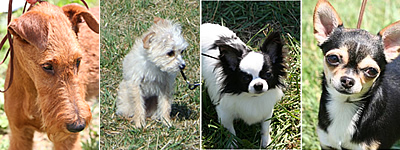Last updated: May 09, 2012
Variants in Three Genes Account for Most Dog Coat Differences

National Human Genome Research Institute
www.genome.gov
Variants in Three Genes Account for Most Dog Coat Differences
Method for Pinpointing Gene Combinations Useful For Studies of Human Disease
 |
Bethesda, Md., Thurs., Aug. 27, 2009 — Variants in just three genes acting in different combinations account for the wide range of coat textures seen in dogs - from the poodle's tight curls to the beagle's stick-straight fur. A team led by researchers from the National Human Genome Research Institute (NHGRI), part of the National Institutes of Health, reports these findings today in the advance online issue of the journal Science.
"This study is an elegant example of using genomic techniques to unravel the genetic basis of biological diversity," said NHGRI Scientific Director Eric Green, M.D., Ph.D. "Genomics continues to gain new insights from the amazing morphological differences seen across the canine species, including many that give clues about human biology and disease."
Until now, relatively little was known about the genes influencing the length, growth pattern and texture of the coats of dogs. The researchers performed a genome-wide scan of specific signposts of DNA variation, called single-nucleotide polymorphisms, in 1,000 individual dogs representing 80 breeds. These data were compared with descriptions of various coat types. Three distinct genetic variants emerged to explain, in combination, virtually all dog hair types.
"What's important for human health is the way we found the genes involved in dog coats and figured out how they work together, rather than the genes themselves," said Elaine A. Ostrander, Ph.D., chief of the Cancer Genetics Branch in NHGRI's Division of Intramural Research. "We think this approach will help pinpoint multiple genes involved in complex human conditions, such as cancer, heart disease, diabetes and obesity."
Artificial selection, at the heart of breeding for desirable traits in domesticated animals, has yielded rapid change in a short span of canine history. While researchers estimate that modern dog breeds diverged from wolves some 15,000 years ago, the genetic changes in the dog genome that create multiple coat types are more likely to have been pursued by breeders in just the past 200 years. In fact, breeds with short, straight hair, such as the beagle, display the original, more wolf-like versions of the three genes identified in the study.
Modern dog breeds are part of a unique population structure, having been selectively bred for many years. Based on this structure, the researchers were able to break down a complex phenotype - coat - into possible genetic variations. "When we put these genetic variants back together in different combinations, we found that we could create most of the coat varieties seen in what is among the most diverse species in the world - the dog," Dr. Ostrander said. "If we can decipher the genetic basis for a complex trait such as the dog's coat, we believe that we can do it as well with complex diseases."
Specifically, the researchers found an alteration in the RSPO2 gene that results in wiry hair that grows in a pattern that gives the dogs a mustachioed look with long details called furnishings. Examples of dogs with wiry coats are Scottish terriers, Irish terriers and schnauzers. Long hair that is silky or fluffy was linked to a variant in the FGF5 gene. Cocker spaniels, Pomeranians and long-haired Chihuahuas are examples of dogs with long coats. A variant in the KRT71 gene produces curly coated dogs, such as the Irish water spaniel. Finally, if all three variants are present, a dog has a long and curly coat with furnishings. Examples of this type of breed include poodles and Portuguese water dogs.
"We don't yet know the precise roles, if any, of these three genes in the variety of hair textures seen among humans," Dr. Ostrander said. The FGF5 (long) gene and KRT71 (curly) gene have been found to affect hair in mice and cats in addition to dogs, so humans may be included as well. The RSPO2 gene has not been previously identified to influence hair texture in mammals, but it does belong to a pathway that has been associated with a coarse hair type found in some people of East Asian ancestry.
The study's lead author, Edouard Cadieu, a graduate student in NHGRI's Cancer Genetics Branch, added, "The carefully controlled breeding of dogs offers advantages in pinpointing the genes that determine particular traits, which may have immediate application to the study of diseases, like cancer, that are common to both dogs and humans."
In addition to Ostrander and her colleagues at NHGRI, the research group included investigators from Cornell University in Ithaca, N.Y.; the University of California, Los Angeles; the University of Utah, Salt Lake City; the Faculty of Medicine, Rennes, France; and Affymetrix Corporation, Santa Clara, Calif.
This latest work utilized and built upon data generated by the NHGRI-supported sequencing and analysis of the dog genome. Researchers can access the dog sequence data through the following public databases: Dog Genome Resources (www.ncbi.nlm.nih.gov/genome/guide/dog) at NIH's National Center for Biotechnology Information (NCBI); EMBL Bank (www.ebi.ac.uk/index.html) at the European Molecular Biology Laboratory's Nucleotide Sequence Database; UCSC Genome Browser (www.genome.ucsc.edu) at the University of California at Santa Cruz; and at the Broad Institute Dog Genome Sequencing Project Web site (www.broad.mit.edu/mammals/dog). Other data may be viewed at dbSNP (www.ncbi.nlm.nih.gov/projects/SNP) at NCBI.
To download photos of dogs that are examples of wiry, short and long coats, go to: www.genome.gov/dmd/img.cfm?node=Photos/Animals/Dog&id=79098, www.genome.gov/dmd/img.cfm?node=Photos/Animals/Dog&id=79099 and www.genome.gov/dmd/img.cfm?node=Photos/Animals/Dog&id=79100.
NHGRI is one of the 27 institutes and centers at the NIH, an agency of the Department of Health and Human Services. The NHGRI Division of Intramural Research develops and implements technology to understand, diagnose and treat genomic and genetic diseases. Additional information about NHGRI can be found at its Web site, www.genome.gov.
The National Institutes of Health - "The Nation's Medical Research Agency" - includes 27 institutes and centers, and is a component of the U.S. Department of Health and Human Services. It is the primary federal agency for conducting and supporting basic, clinical and translational medical research, and it investigates the causes, treatments and cures for both common and rare diseases. For more, visit www.nih.gov.
Contact
Geoff Spencer
301-402-0911
spencerg@mail.nih.gov
